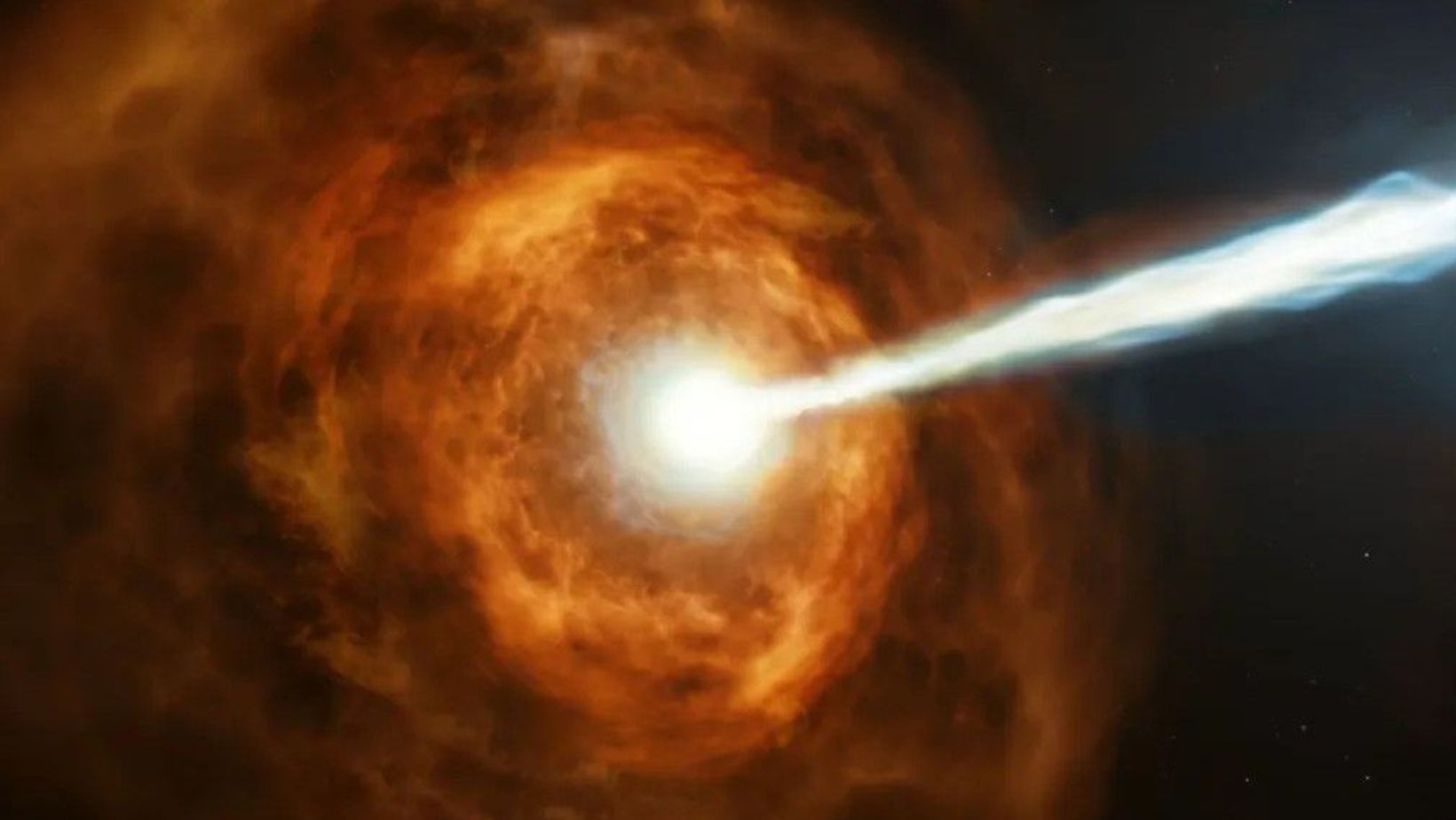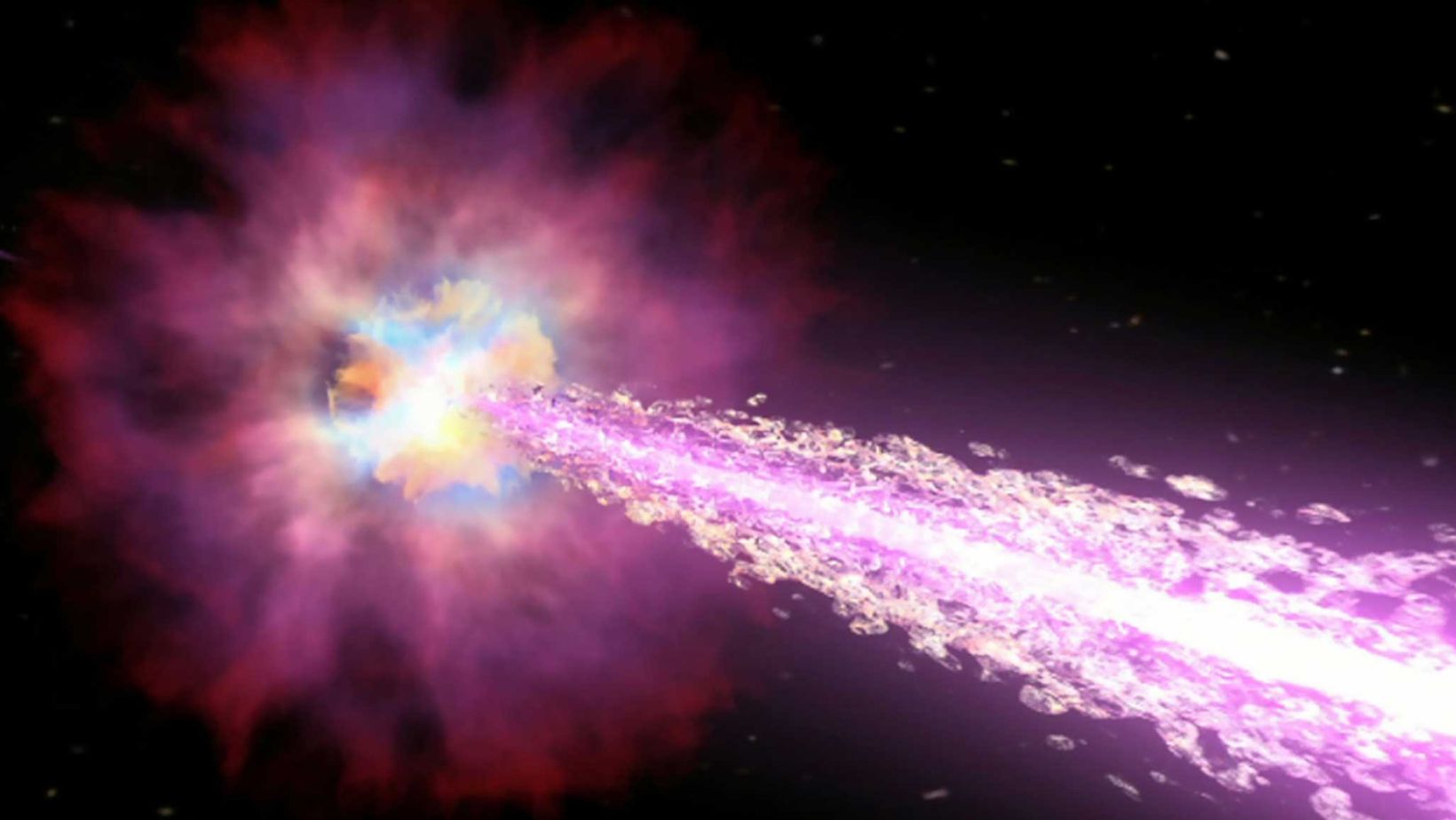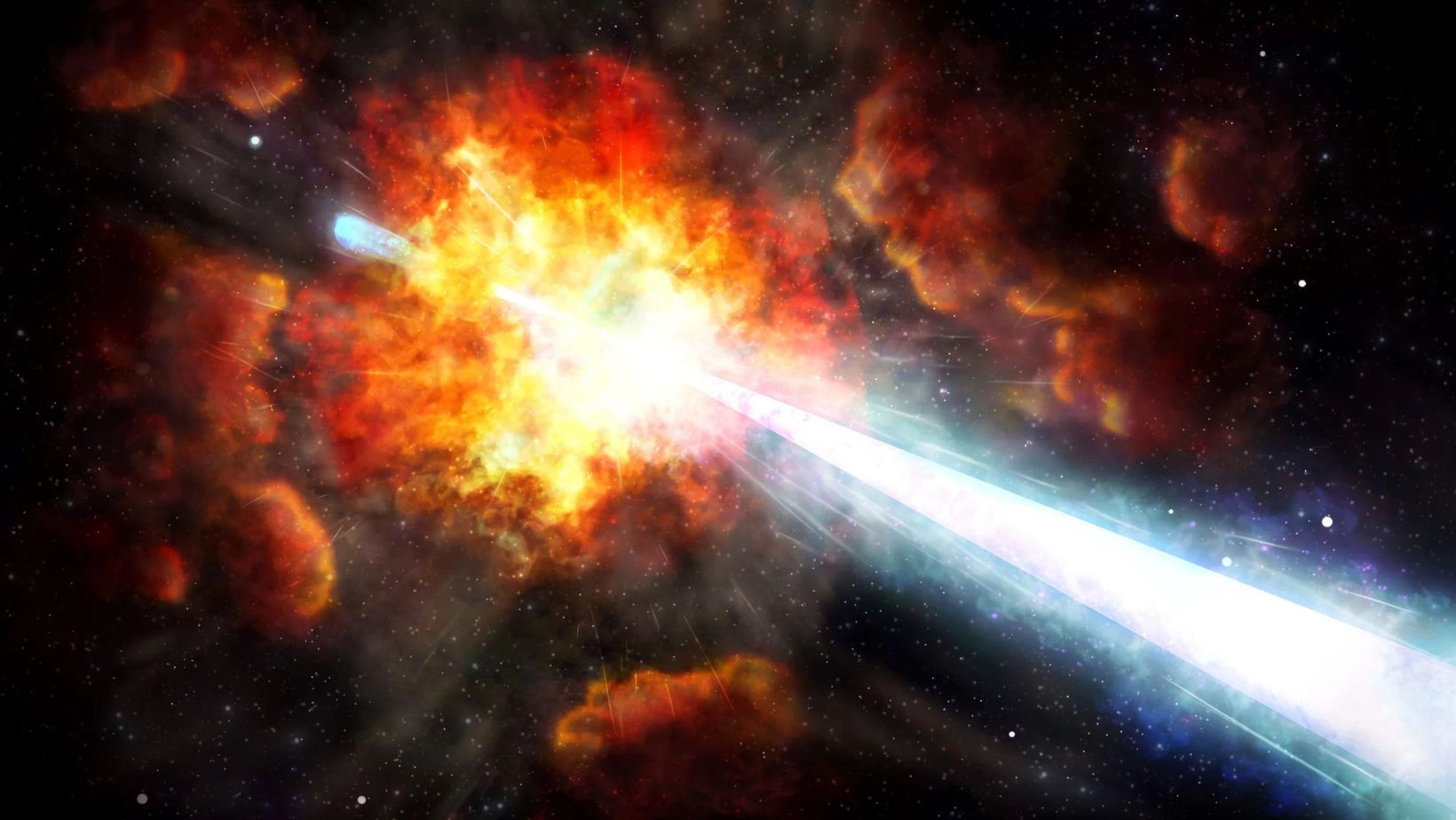Gamma-ray bursts (GRBs) are the universe’s most powerful explosions. These intense flashes of energy outshine entire galaxies for brief moments. They release more energy in a few seconds than the Sun will in its entire lifetime. But what exactly are GRBs, and why do they captivate astronomers and scientists alike? These cosmic events occur when massive stars collapse or when two neutron stars collide. GRBs give us a glimpse into the extreme forces at work in the universe. Let’s dive deeper into what makes GRBs the universe’s ultimate spectacle of destruction and creation.
What Are Gamma-Ray Bursts?

Gamma-ray bursts (GRBs) are intense flashes of gamma radiation, the highest-energy form of light. These bursts are the most powerful explosions in the universe, releasing enormous amounts of energy in a brief period. They were first discovered in the 1960s by military satellites monitoring nuclear tests. GRBs are crucial to astrophysics as they provide insights into the most extreme processes in space.
There are two primary types of GRBs: long-duration and short-duration. Long-duration GRBs last more than two seconds and are usually associated with the collapse of massive stars into black holes. These events often result in supernovae and the formation of a black hole. On the other hand, short-duration GRBs last less than two seconds and are linked to the merger of compact objects, like neutron stars or black holes.
Understanding GRBs is important for studying high-energy astrophysics, black holes, and stellar evolution. They also offer a unique way to observe distant galaxies and the early universe. By analyzing the light from these bursts, scientists can probe the physical conditions of space far beyond our reach.
The Power Behind Gamma-Ray Bursts
Gamma-ray bursts (GRBs) are among the most energetic events in the universe. These brief but intense flashes of gamma rays release more energy in seconds than our Sun will emit in its entire lifetime. The source of this immense energy is believed to be either the collapse of massive stars or the collision of compact objects like neutron stars. This explosion creates a jet of high-energy radiation that can travel across vast distances.
Compared to other cosmic events like supernovae, GRBs are far more powerful. While a supernova occurs when a star explodes, a GRB can release up to 10 times more energy in a fraction of the time. Supernovae are relatively slower, lasting days to weeks, while GRBs last just a few seconds to minutes. The key difference lies in the speed and focus of the energy release, with GRBs being highly concentrated and more intense.
Understanding GRBs helps scientists unlock the mysteries of the universe, including the processes behind black holes and neutron stars. The immense energy involved in these events makes them crucial to the study of cosmic evolution.
The Discovery of Gamma-Ray Bursts
Gamma-ray bursts (GRBs) are powerful explosions in space that release intense bursts of gamma radiation. They were first discovered by accident in 1967 by the Vela satellites, which were designed to monitor nuclear weapons tests. These satellites detected bursts of gamma rays coming from deep space, far beyond our solar system. Initially, scientists were puzzled about their origin and nature.
Research into GRBs accelerated after their detection, leading to the development of specialized instruments. In the 1990s, the NASA-funded Compton Gamma Ray Observatory helped pinpoint more GRB sources. The discovery of their distant origins changed our understanding of the universe’s most violent events. By the early 2000s, the Swift satellite mission was launched to study GRBs more closely.
NASA’s satellites, including Swift and Fermi, played a key role in observing and analyzing these bursts. Swift’s fast response capabilities allowed researchers to locate GRB afterglows in optical, X-ray, and radio wavelengths. Fermi, launched in 2008, improved our understanding of high-energy astrophysics. These missions continue to provide valuable data, unlocking the mysteries of GRBs and their connection to stellar evolution and black hole formation.
How Do Gamma-Ray Bursts Form?
Gamma-ray bursts (GRBs) are intense bursts of gamma radiation, the most powerful explosions observed in the universe. They form in two primary ways: supernova collapses and neutron star mergers. In the first case, a massive star runs out of fuel and collapses under its own gravity. This collapse leads to a supernova explosion, which can trigger a GRB if the resulting black hole or neutron star emits high-energy jets of radiation.
The second theory involves neutron star mergers. When two neutron stars orbit each other closely, they can eventually collide. This collision creates a violent event, releasing enormous amounts of energy, including gamma rays. Both theories suggest that GRBs are linked to the formation of black holes or highly magnetized neutron stars, which are essential for generating the intense bursts of energy.
Understanding these origins helps scientists study the most energetic events in the cosmos. Researchers continue to explore the exact mechanisms behind GRBs. Each discovery sheds light on the end stages of stellar evolution and the behavior of extreme matter. By investigating GRBs, we learn more about the universe’s most dramatic phenomena.
The Mechanics of a Long-Duration GRB
Long-duration Gamma-Ray Bursts (GRBs) are intense bursts of gamma radiation, lasting more than two seconds. They are believed to occur when massive stars, at least 30 times the mass of our Sun, collapse. This collapse leads to the formation of a black hole at the star’s core. As the star collapses, it triggers an explosion, releasing a vast amount of energy in the form of gamma rays.
The process begins with the star exhausting its nuclear fuel. This causes the core to contract, and the outer layers to explode in a supernova. The collapsing core reaches extremely high densities, and a black hole forms. The energy released during this collapse is what generates the powerful GRB.
Jets of particles are ejected at nearly the speed of light during this collapse. These jets are responsible for the gamma rays that we observe as GRBs. The exact mechanisms behind the formation of the jets are complex but involve intense magnetic fields and rapid rotation. These jets, when aligned with Earth, produce the long-duration GRB signature we detect.
The Short-Duration GRB: A Different Explosion

Short-duration Gamma-Ray Bursts (GRBs) are intense bursts of gamma radiation, lasting less than two seconds. They are distinct from long-duration GRBs, which are linked to massive star collapses. The primary cause of short-duration GRBs is the merger of two neutron stars. These mergers lead to catastrophic explosions, releasing a tremendous amount of energy.
Neutron stars are the remnants of massive stars that have exploded in supernovae. When two neutron stars collide, their matter is compressed and heated, triggering an explosion. This explosion releases gamma rays, which are detected as short-duration GRBs. The event also produces heavy elements like gold and platinum, dispersing them into space.
The aftermath of a neutron star merger can also create black holes. These black holes can continue to emit radiation, but the initial burst is the most significant. Scientists are studying these events to understand more about the physics of extreme environments. Observations from telescopes have provided critical insights into the nature of short-duration GRBs.
The Aftermath: Afterglows and Their Importance
After a Gamma-Ray Burst (GRB) fades, an afterglow often remains visible for days to weeks. This afterglow is emitted in various wavelengths, including X-rays, optical, and radio waves. It provides crucial information about the environment surrounding the burst and the properties of the GRB itself. The afterglow gradually dims as the energy from the burst dissipates.
The significance of afterglows lies in their role in studying GRBs. These afterglows help astronomers determine the distance of the GRB, the structure of the explosion, and the material around it. By analyzing the afterglow’s light curve and spectrum, scientists can infer the speed at which the explosion’s debris is expanding. This information contributes to our understanding of the origins and mechanisms behind GRBs, which are still not fully understood.
In summary, the afterglows of GRBs provide valuable insights into one of the universe’s most energetic phenomena. They allow scientists to gather data that would otherwise be hidden in the intense burst of gamma rays. Afterglows remain a critical tool in unlocking the mysteries of GRBs and their impact on the universe.
Gamma-Ray Bursts and Their Impact on Our Understanding of the Universe
Gamma-Ray Bursts (GRBs) are some of the most powerful explosions in the universe, releasing enormous amounts of energy in the form of gamma rays. These bursts are crucial to our understanding of cosmic evolution, as they offer insight into the life cycles of massive stars and the processes that lead to their destruction. By studying GRBs, scientists can learn about the formation of black holes, the behavior of high-energy particles, and the conditions of the early universe. They also provide a glimpse into the extreme environments that exist in distant galaxies.
GRBs play a significant role in studying the early universe. Because these bursts can be detected across vast distances, they act as cosmic beacons, allowing us to observe phenomena that occurred billions of years ago. This helps scientists explore the conditions in the universe shortly after the Big Bang, particularly in the formation of the first stars and galaxies. By analyzing the light from GRBs, astronomers can map the distribution of matter and the evolution of the cosmos during its infancy.
Can Gamma-Ray Bursts Affect Earth?
Gamma-Ray Bursts (GRBs) are intense bursts of gamma radiation, typically originating from massive stars collapsing or from neutron star mergers. These bursts release energy equivalent to the Sun’s entire lifetime in just a few seconds. There has been much speculation about whether these bursts could pose a threat to life on Earth. The primary concern is that if a GRB were to occur close enough, its radiation could damage the Earth’s atmosphere and potentially harm life.
However, GRBs are extremely rare, and their occurrence near Earth is unlikely. Most GRBs are located billions of light-years away. Even if one were to happen within our galaxy, the distance from Earth would likely offer a protective buffer. The safety factor is high, with most GRBs occurring far outside the range that would pose a significant threat.
Scientists have estimated that for a GRB to affect Earth, it would need to be within about 1,000 light-years. This distance is far beyond the closest stars to our planet. In reality, the likelihood of a nearby GRB occurring is minimal, making the potential for catastrophic effects extremely rare. Therefore, while GRBs are fascinating, their impact on Earth remains a theoretical concern rather than an immediate threat.
The Future of Gamma-Ray Burst Research
Gamma-ray bursts (GRBs) are the most powerful explosions in the universe, and ongoing research is focused on understanding their origins and mechanics. New missions, like NASA’s James Webb Space Telescope and the upcoming GRB-focused observatories, aim to gather more detailed data on these events. These advancements will help astronomers observe GRBs from their birth to their aftereffects, revealing insights into black holes, neutron stars, and the extreme physics at play. Researchers hope to better understand the relationship between GRBs and the formation of black holes and other stellar remnants.
In the future, astronomers aim to discover more about the triggers of GRBs and their connection to the early universe. By studying the distance and frequency of these explosions, scientists hope to trace cosmic evolution over billions of years. They also aim to identify the precise conditions that lead to the formation of a GRB and explore whether they can be used as “cosmic markers” for measuring the universe’s expansion. As technology and research methods improve, GRBs will continue to be a key focus in astrophysical research, offering deeper insights into the fundamental forces that govern the cosmos.
Conclusion: The Mystery of Gamma-Ray Bursts: The Universe’s Most Powerful Explosions

Gamma-ray bursts (GRBs) remain one of the most enigmatic phenomena in astrophysics. These powerful, high-energy events provide insight into the violent processes that shape the universe, such as the death of massive stars and the merging of neutron stars. Despite extensive research, the exact mechanisms behind GRBs are still not fully understood. Their study continues to captivate scientists, with new observations and theories emerging as technology improves. GRBs hold the potential to unlock fundamental secrets about the universe’s origins, and their ongoing exploration is a testament to humanity’s drive to understand the cosmos.
FAQs About The Mystery of Gamma-Ray Bursts: The Universe’s Most Powerful Explosions
What exactly causes a gamma-ray burst?
Gamma-ray bursts (GRBs) are intense explosions that occur in distant galaxies. They are typically caused by the collapse of massive stars into black holes or by the merger of two neutron stars. These events release an enormous amount of energy, often outshining the rest of the galaxy for a brief period.
How are gamma-ray bursts detected by astronomers?
GRBs are detected using space-based telescopes equipped with specialized instruments that can pick up high-energy radiation, including gamma rays. Notable missions like NASA’s Swift satellite have been instrumental in identifying and studying GRBs, helping scientists capture the burst’s light and study its aftereffects.
Why are gamma-ray bursts so important for understanding the universe?
GRBs provide valuable insights into the extreme physics of the universe. Studying these bursts helps astronomers understand the formation of black holes, the behavior of matter under extreme conditions, and the evolution of galaxies over cosmic time scales.
Can gamma-ray bursts affect life on Earth?
While gamma-ray bursts are incredibly powerful, the chances of one occurring close enough to Earth to cause significant harm are extremely low. The closest known GRB was about 2 billion light-years away, far enough that it posed no threat to our planet. Nonetheless, if one were to occur within a few thousand light-years, it could potentially affect the Earth’s atmosphere and life.
How do gamma-ray bursts differ from supernovae?
While both are explosive cosmic events, gamma-ray bursts are distinct from supernovae. A supernova is the explosion of a dying star, which can also produce gamma rays, but GRBs are typically associated with specific types of stellar collapses or mergers. GRBs are much more energetic and can release concentrated beams of gamma rays in a focused direction, whereas supernovae emit radiation in all directions.

